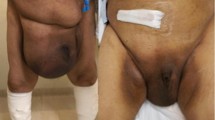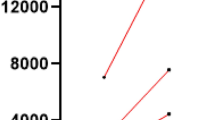Abstract
Introduction
Goni Moreno’s procedure was described 60 years ago as a solution for giant hernias repair through the creation of a progressive preoperative pneumoperitoneum (PPP). The main objective of the present study is to assess its effectiveness in terms of primary fascial closures. The secondary objectives of this study are to explore the morbidity and mortality associated with Moreno’s procedure using 40 years of data from a large cohort of patients.
Materials and methods
This is a retrospective study of all patients who underwent PPP procedures between October 1974 and January 2019 at the digestive surgery unit at Grenoble University Hospital, France. Data were reviewed to assess the preoperative demographic characteristics of the patients, procedure, postoperative course, complication following Clavien–Dindo classification and 30-day outcomes.
Results
162 procedures were attempted. The mean age of patients was 57.8 years. 83 patients had a history of chronic respiratory disease (51.2%). The mean BMI was 33.2 kg/m2, and 52 patients were obese (32.1%) Half of the patients were classified as ASA score III. Success rate of fascial closures was 95.7%. The global rate of complication during the insufflation period and after surgical repair of the hernia was 51.8% (n = 84). Among these, only 16.7% (n = 27) were major according to the Clavien–Dindo classification. The global mortality rate was 3.1%.
Conclusion
Goni Moreno PPP is an effective procedure that allows a high rate of fascial closure. The population of patients requiring such procedures presents a high-risk profile for complications regarding demographics and associated diseases.

Similar content being viewed by others
References
Muysoms FE, Miserez M, Berrevoet F, Campanelli G, Champault GG, Chelala E et al (2009) Classification of primary and incisional abdominal wall hernias. Hernia 13:407–414
Passot G, Villeneuve L, Sabbagh C, Renard Y, Regimbeau J-M, Verhaeghe P et al (2016) Definition of giant ventral hernias: development of standardization through a practice survey. Int J Surg 28:136–140
Trivellini G, Zanella G, Danelli PG, Pratolongo D, Ferri O (1984) Surgical treatment of large eventrations. Study of a technic adapted to disorders of respiratory compliance. Chir Mem Acad Chir 110:116–122
Munegato G, Brandolese R (2001) Respiratory physiopathology in surgical repair for large incisional hernias of the abdominal wall. J Am Coll Surg 192:298–304
Goñi Moreno I (1971) Pneumoperitoneum applied to the surgical preparation of large chronic eventrations. Prensa Med Argent 58:1037–1041
Sabbagh C, Dumont F, Robert B, Badaoui R, Verhaeghe P, Regimbeau J-M (2011) Peritoneal volume is predictive of tension-free fascia closure of large incisional hernias with loss of domain: a prospective study. Hernia 15:559–565
Alam NN, Narang SK, Pathak S, Daniels IR, Smart NJ (2016) Methods of abdominal wall expansion for repair of incisional herniae: a systematic review. Hernia 20:191–199
Valezi AC, de Melo BGF, Marson AC, Liberatti M, Lopes AG (2018) Preoperative progressive pneumoperitoneum in obese patients with loss of domain hernias. Surg Obes Relat Dis 14:138–142
Minossi JG, de Oliveira WK, Llanos JC, Ielo SM, Hasimoto CN, Pereira RSC (2009) Preoperative progressive pneumoperitoneum in voluminous abdominal wall hernias. Arq Gastroenterol 46:121–126
Willis S, Schumpelick V (2000) Use of progressive pneumoperitoneum in the repair of giant hernias. Hernia 4:105–111
Mayagoitia JC, Suárez D, Arenas JC, de León VD (2006) Preoperative progressive pneumoperitoneum in patients with abdominal-wall hernias. Hernia 10:213–217
Oprea V, Matei O, Gheorghescu D, Leuca D, Buia F, Rosianu M et al (2014) Progressive preoperative pneumoperitoneum (PPP) as an adjunct for surgery of hernias with loss of domain. Chirurgia Bucur 109(5):664–669
Sabbagh C, Dumont F, Fuks D, Yzet T, Verhaeghe P, Regimbeau J-M (2012) Progressive preoperative pneumoperitoneum preparation (the Goni Moreno protocol) prior to large incisional hernia surgery: volumetric, respiratory and clinical impacts. A prospective study. Hernia 16(1):33–40
Renard Y, Lardière-Deguelte S, de Mestier L, Appere F, Colosio A, Kianmanesh R et al (2016) Management of large incisional hernias with loss of domain: a prospective series of patients prepared by progressive preoperative pneumoperitoneum. Surgery 160:426–435
Bueno-Lledó J, Torregrosa A, Ballester N, Carreño O, Carbonell F, Pastor PG et al (2017) Preoperative progressive pneumoperitoneum and botulinum toxin type A in patients with large incisional hernia. Hernia 21:233–243
Toniato A, Pagetta C, Bernante P, Piotto A, Pelizzo M (2002) Incisional hernia treatment with progressive pneumoperitoneum and retromuscular prosthetic hernioplasty. Langenbecks Arch Surg 387:246–248
Murr MM, Mason EE, Scott DH (1994) The use of pneumoperitoneum in the repair of giant hernias. Obes Surg 4:323–327
Lindmark M, Strigard K, Löwenmark T, Dahlstrand U, Gunnarsson U (2018) Risk factors for surgical complications in ventral hernia repair. World J Surg 42:3528–3536
Deerenberg EB, Timmermans L, Hogerzeil DP, Slieker JC, Eilers PHC, Jeekel J et al (2015) A systematic review of the surgical treatment of large incisional hernia. Hernia 19:89–101
Owei L, Swendiman RA, Kelz RR, Dempsey DT, Dumon KR (2017) Impact of body mass index on open ventral hernia repair: a retrospective review. Surgery 162:1320–1329
Giordano SA, Garvey PB, Baumann DP, Liu J, Butler CE (2017) The impact of body mass index on abdominal wall reconstruction outcomes: a comparative study. Plast Reconstr Surg 139:1234
Docimo S, Spaniolas K, Svestka M, Bates AT, Sbayi S, Schnur J et al (2018) Increased incidence of surgical site infection with a body mass index ≥ 35 kg/m2 following abdominal wall reconstruction with open component separation. Surg Endosc. https://doi.org/10.1007/s00464-018-6538-9
Tastaldi L, Krpata DM, Prabhu AS, Petro CC, Rosenblatt S, Haskins IN et al (2019) The effect of increasing body mass index on wound complications in open ventral hernia repair with mesh. Am J Surg
Khorgami Z, Hui BY, Mushtaq N, Chow GS, Sclabas GM (2018) Predictors of mortality after elective ventral hernia repair: an analysis of national inpatient sample. Hernia. https://doi.org/10.1007/s10029-018-1841-x
Basta MN, Fischer JP, Wink JD, Kovach SJ (2016) Mortality after inpatient open ventral hernia repair: developing a risk stratification tool based on 55,760 operations. Am J Surg 211:1047–1057
Tanaka EY, Yoo JH, Rodrigues AJ, Utiyama EM, Birolini D, Rasslan S (2010) A computerized tomography scan method for calculating the hernia sac and abdominal cavity volume in complex large incisional hernia with loss of domain. Hernia 14:63–69
Author information
Authors and Affiliations
Corresponding author
Ethics declarations
Conflict of interest
The authors declare that they have no conflict of interest.
Ethical approval
In accordance with the law on medical research in our country concerning retrospective and non-interventional study, all patients have received a written information on the study and have had the opportunity to refuse to participate. The whole study and protocol were approved by a local ethic committee.
Human and animal rights
The study including human participants has been performed in accordance with the ethical standards of the declaration of Helsinki and its later amendments.
Informed consent
For this retrospective review, formal consent is not required.
Additional information
Publisher's Note
Springer Nature remains neutral with regard to jurisdictional claims in published maps and institutional affiliations.
Rights and permissions
About this article
Cite this article
Mancini, A., Mougin, N., Venchiarutti, V. et al. Goni Moreno progressive preoperative pneumoperitoneum for giant hernias: a monocentric retrospective study of 162 patients. Hernia 24, 545–550 (2020). https://doi.org/10.1007/s10029-019-02113-5
Received:
Accepted:
Published:
Issue Date:
DOI: https://doi.org/10.1007/s10029-019-02113-5




